William Hemsley stands as a notable figure within the bustling art scene of Victorian Britain. Born in London in 1819 and passing away in the same city in 1906, his lifespan coincided with a period of immense social, industrial, and cultural transformation. Hemsley dedicated his artistic career primarily to genre painting, capturing the nuances of everyday life with a keen eye for detail, narrative, and often, gentle humour or sentiment. Though perhaps not as revolutionary as some of his contemporaries, his work offers a valuable window into the domestic interiors, rural settings, and social interactions that characterized the era, making him a significant chronicler of his time.
Early Life and Artistic Beginnings
William Hemsley entered the world in London, a city rapidly expanding and evolving. While detailed records of his earliest years and formal education are somewhat scarce, it is understood that his initial professional training was not in fine art but in architecture. This architectural background may have subtly influenced his later paintings, perhaps contributing to his careful structuring of interior spaces and attention to the built environment within his compositions.
However, the allure of painting eventually proved stronger than that of architectural design. Hemsley transitioned towards becoming a professional artist, likely honing his skills through dedicated self-study, observation of works by established masters, and potentially informal guidance. The precise moment or catalyst for this shift remains unclear, but by the mid-19th century, he was actively pursuing a career as a painter, focusing on the subjects that would define his oeuvre: the intimate moments and characteristic scenes of Victorian life.
A Career in Genre Painting
Hemsley established himself as a consistent and recognized painter of genre scenes. His chosen specialty resonated deeply with the tastes of the Victorian public, particularly the burgeoning middle class, who appreciated relatable depictions of domesticity, childhood, work, and leisure. Genre painting, with its focus on ordinary people and everyday activities, offered narrative, moral lessons, or simply comforting familiarity, making it a highly popular art form throughout the 19th century.
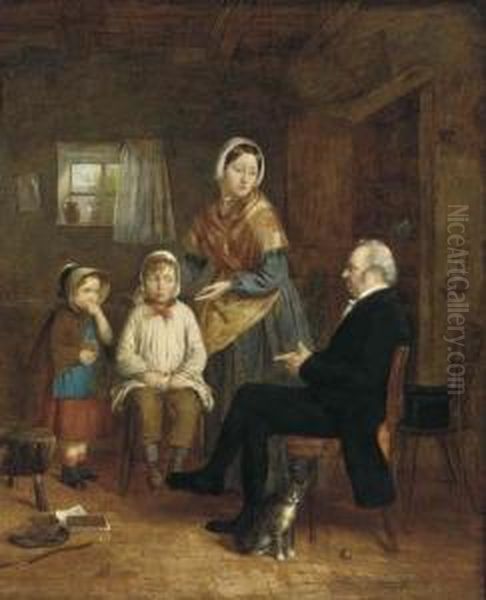
He became a regular exhibitor at London's most prestigious art institutions. Records show his works were frequently displayed at the Royal Academy of Arts, a primary venue for artists seeking recognition and patronage. Hemsley also exhibited extensively at the British Institution and, significantly, at the galleries of the Royal Society of British Artists (RBA) located on Suffolk Street. His connection with the RBA was particularly strong; he was elected a member of the society, signifying the respect he commanded among his peers. His consistent presence at these exhibitions ensured his work reached a wide audience and contributed to his reputation as a reliable and skilled genre painter.
Themes and Subjects: Capturing Everyday Moments
The core of William Hemsley's artistic output lies in his dedication to capturing the fabric of everyday Victorian life. His canvases are populated with scenes drawn from domestic interiors, rural cottages, village streets, and schoolrooms. Children are frequent protagonists in his work, depicted with a blend of affection and realism. He painted them at play, engrossed in lessons, engaging in minor mischief ('The Truant' being a classic example), or experiencing moments of quiet contemplation. These portrayals often carried a sentimental or gently humorous tone, appealing directly to Victorian ideals of childhood innocence and familial warmth.
Beyond childhood, Hemsley explored various facets of adult life. He depicted scenes of quiet domesticity – families gathered, individuals reading ('Reading the News'), or engaged in simple household tasks. Rural life also featured prominently, with paintings set in rustic cottage interiors or showing interactions within village communities. Often, his works contained a narrative element, inviting viewers to piece together a story or reflect on the situation presented. Titles like 'Sunday Morning', 'Grandfather's Story', or 'A Pinch of Snuff' clearly indicate this anecdotal approach, transforming simple scenes into relatable vignettes.
Artistic Style and Technique
Hemsley's style is firmly rooted in the Victorian tradition of detailed realism and narrative clarity. He possessed a proficient technique, rendering figures, objects, and settings with considerable care and attention to detail. His architectural background might be discerned in the structured composition of his interior scenes, where furniture, windows, and domestic clutter are depicted with solidity and accuracy. He paid close attention to textures – the roughness of a stone floor, the weave of fabric, the gleam of polished wood – adding to the tactile quality and realism of his work.
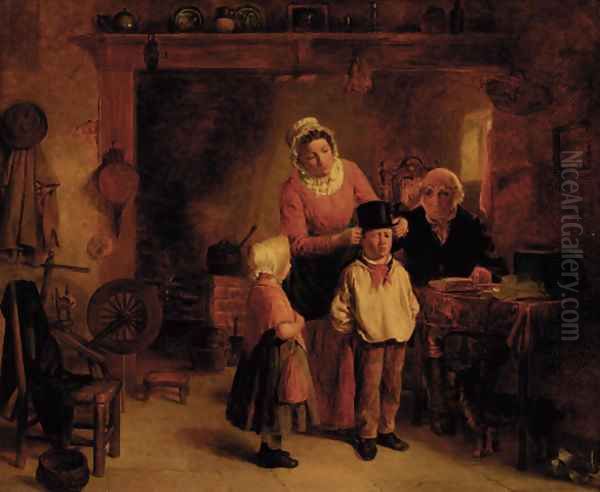
His use of light and shadow was typically employed to enhance the narrative focus and create mood, often illuminating the central figures or action within the scene. While not overtly dramatic, his lighting contributed to the sense of intimacy and enclosure, particularly in his interior subjects. His colour palette was generally naturalistic, reflecting the tones and hues of everyday Victorian environments. Compared to some contemporaries, his brushwork might be described as relatively tight and controlled, prioritizing clear representation over expressive texture, which suited the narrative and descriptive aims of his genre painting. His approach shares affinities with other Victorian genre specialists like Thomas Webster, known for similar themes of village life and childhood.
Representative Works
Several paintings stand out as representative of William Hemsley's style and thematic concerns. 'Bird's Nesting', for example, captures a group of children engaged in a countryside pursuit, blending innocence with the potential for mischief, a common theme in his work. The detail in the rendering of the natural setting and the expressive postures of the children are characteristic of his approach.
'Sunday Morning' likely depicts a family preparing for or returning from church, embodying the Victorian emphasis on piety and domestic order. Such scenes reinforced societal values and offered viewers a comforting image of family life. 'Reading the News' focuses on the simple act of staying informed, often showing an older individual engrossed in a newspaper, perhaps surrounded by family. This theme reflects the increasing literacy rates and the importance of print media in the 19th century.
'The Truant' portrays a child caught skipping school, a scenario blending humour with a gentle moral lesson about duty and consequence. 'A Pinch of Snuff' might depict an older character indulging in a common habit, offering a moment of character study and social observation. 'Grandfather's Story' would typically show an intergenerational scene, emphasizing family bonds and the transmission of knowledge or tradition. These works, among many others, exemplify Hemsley's commitment to detailed, narrative genre scenes drawn from the life around him.
Victorian Context and the Appeal of Genre
To fully appreciate William Hemsley's work, it's essential to place him within the broader context of Victorian art and society. The 19th century saw a significant expansion of the art market, driven largely by the wealth generated through industrialization and the rise of a prosperous middle class. This new audience often favoured art that was relatable, understandable, and reflected their own values and experiences. Genre painting, with its focus on everyday life, narrative potential, and often moral undertones, perfectly met these demands.
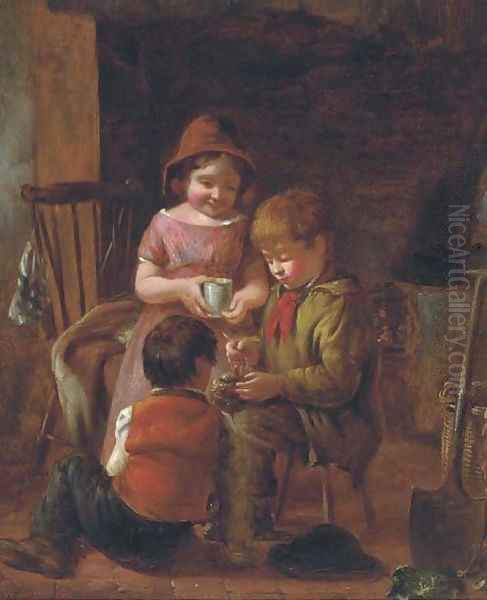
Artists like Hemsley provided accessible images that celebrated domestic virtue, childhood innocence, rural simplicity, and the quiet dramas of ordinary existence. These themes offered comfort and affirmation in a time of rapid change and social upheaval. The narrative quality was particularly prized; paintings were often 'read' like visual stories, inviting interpretation and discussion. Exhibitions at the Royal Academy and elsewhere became major social events, and engravings made after popular paintings disseminated these images even more widely, making artists like Hemsley household names among the art-buying public.
The detailed realism prevalent in much Victorian genre painting also appealed to an audience fascinated by scientific observation and empirical truth. The meticulous rendering of objects, textures, and social types provided a sense of authenticity and allowed viewers to immerse themselves in the depicted scene. While sometimes criticized for sentimentality or anecdotal triviality, genre painting was a dominant force in British art for much of Hemsley's career.
Contemporaries and Influences
William Hemsley worked alongside a large number of talented artists specializing in genre painting during the Victorian era. His work can be considered in relation to figures such as Thomas Webster (1800-1886), whose depictions of village school scenes and childhood games share thematic similarities with Hemsley's output. William Powell Frith (1819-1909), Hemsley's exact contemporary by birth year, achieved enormous fame with his large-scale panoramas of modern life like 'Derby Day' and 'The Railway Station', though Frith operated on a grander, more complex scale than Hemsley typically did.
Other notable genre painters of the period include Frederick Daniel Hardy (1827-1911) and his brother George Hardy (1822-1909), associated with the Cranbrook Colony, who painted intimate domestic interiors with meticulous detail. George Bernard O'Neill (1828-1917), another Cranbrook artist, also focused on charming scenes of rural and family life. The works of Augustus Egg (1816-1863) often carried stronger social commentary or moral narratives, sometimes in triptych form, exploring themes like marital infidelity.
Abraham Solomon (1823-1862) was known for narrative paintings contrasting different social situations, such as his famous pair 'First Class' and 'Second Class'. The Scottish painter Erskine Nicol (1825-1902) often depicted scenes of Irish peasant life, sometimes with humorous or stereotypical elements. Myles Birket Foster (1825-1899), primarily a watercolourist, created idealized visions of English rural life and childhood that were immensely popular.
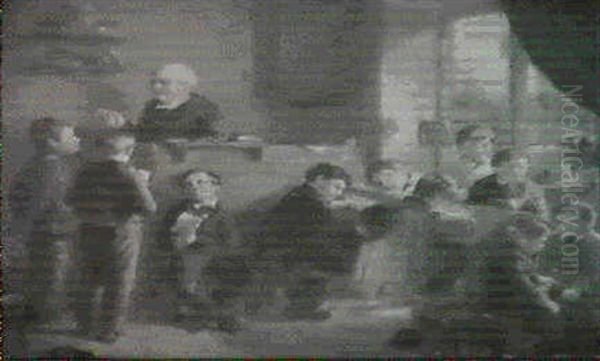
We can also mention George Smith (1829-1901), who painted detailed domestic and historical genre scenes, and James Collinson (1825-1881), initially a member of the Pre-Raphaelite Brotherhood who later turned to sentimental genre subjects. Later in Hemsley's career, artists like Walter Dendy Sadler (1854-1923) and Heywood Hardy (1842-1933) continued the tradition of narrative and historical genre painting. While direct influence is hard to pinpoint, Hemsley's work certainly drew from the broader tradition of British genre painting established earlier by artists like Sir David Wilkie, and perhaps looked back to the detailed domestic scenes of 17th-century Dutch masters like Adriaen van Ostade or Jan Steen.
Later Life and Legacy
William Hemsley continued to paint and exhibit throughout the latter half of the 19th century, maintaining his focus on the genre subjects that had brought him recognition. He remained based in London, the centre of the British art world, until his death in 1906. By the time of his passing, the artistic landscape was beginning to change significantly. The rise of Impressionism, Post-Impressionism, and various avant-garde movements in Britain and continental Europe gradually shifted critical and public taste away from the detailed narrative realism that Hemsley practiced.
Consequently, Hemsley's reputation, like that of many Victorian genre painters, somewhat declined in the early 20th century. His work might have been seen as overly sentimental or illustrative compared to the emerging modernist aesthetics. However, in more recent decades, there has been a renewed appreciation for Victorian art, including genre painting. Hemsley's work is now valued not only for its technical skill and contemporary popularity but also as a rich source of social documentation.
His paintings offer valuable insights into the clothing, interiors, customs, and social attitudes of the Victorian period. They capture aspects of childhood, family life, and rural communities that might otherwise be less visually recorded. While he may not have been an innovator who drastically altered the course of art history, William Hemsley was a skilled and sensitive observer of his time, creating a body of work that continues to engage viewers with its charm, detail, and narrative appeal. He holds a secure place as a representative practitioner of Victorian genre painting.
Conclusion: A Painter of Victorian England
William Hemsley carved a distinct niche for himself within the vibrant art world of 19th-century Britain. As a dedicated genre painter, he turned his artistic lens onto the everyday lives of ordinary Victorians, capturing moments of domesticity, childhood play, rural labour, and quiet contemplation. His works, characterized by careful detail, narrative clarity, and often a touch of sentiment or humour, resonated strongly with the tastes of his time, earning him recognition through regular exhibitions at major London institutions like the Royal Academy and the Royal Society of British Artists.
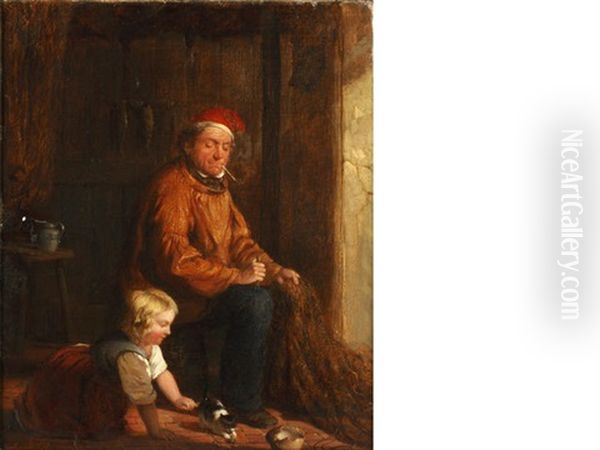
Though perhaps overshadowed in art historical narratives by more revolutionary figures or those tackling grander historical or mythological themes, Hemsley's contribution remains significant. His paintings serve as more than just charming anecdotes; they are valuable historical documents, offering visual insights into the social fabric, customs, and environments of Victorian England. Working alongside contemporaries like Thomas Webster, William Powell Frith, and the artists of the Cranbrook Colony, Hemsley helped define a key aspect of British art in his era. His legacy lies in his ability to find enduring interest and quiet drama in the commonplace, leaving behind a body of work that continues to illuminate the human side of the Victorian age.